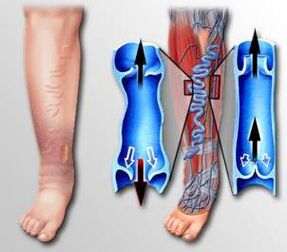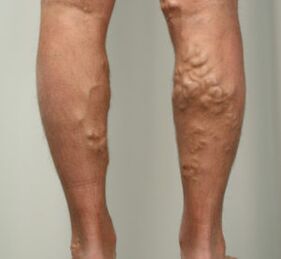
Varicose veins of the lower extremities - the appearance of spider veins (nets) and varicose veins on the legs. The disease, which is common in the adult population, is more common in women than in men.
The disease got this name when translated from Latin, it literally means: obesity, enlargement.
The first sensations of this disease are very different for each patient, but the feeling of heaviness in the legs, rapid fatigue, pain in the length of the vein unites everyone.
Treatment should be selected by an experienced physician who can objectively assess the stage and development of the disease.
The pathology, which is often just a cosmetic defect, nevertheless, in some cases, can lead to serious complications and permanent disability.
What are varicose veins, mechanisms of pathology development

After 40 years, some people may experience a rather unpleasant condition - the appearance of varicose veins on their legs. Small purple pots that reach into the skin, are woven into a spider web or look like a tightly branched tree, are a serious cosmetic problem for many, especially women. "Out of nowhere" vascular networks (the term telangiectasia is used in medicine) is an enlargement of small veins less than 1 millimeter in diameter, located in the thickness of the skin. This is one of the signs that a person has varicose veins in their legs.
If the nodules start above the surface of the skin, with a soft touch that becomes more noticeable when the person is standing, then we can talk about another manifestation. This is an already more serious pathology - varicose enlargement of large and small ruptured veins, as well as their branches.
The veins in the legs are soft, thin-walled canals that return blood to the heart. Against the force of gravity, nature provided them with valves that prevent blood from flowing back (reflux). There are two venous systems in the lower extremities: superficial and deep. The first is represented by vessels that are under the skin, so they can be seen. The second is the deep veins of the legs, which are located in the thickness of the muscles next to the bones. Between these systems is communication - perforated veins.
The inability of the valves to perform their function causes blood to stagnate in the lower parts, with its "excess" discharge through perforated veins from deep to superficial. This, in turn, creates increased pressure in the venous system of the legs, which is located under the skin. What makes his ships respond is "shredding and lengthening. "And therefore varicose veins occur in the legs.
Causes of development
There are many conditions that cause valve damage and loss of elasticity in the vessel wall. There are crucial causes of varicose veins in the legs that are most often associated with this disease:
- Age. Over the years our veins lose elasticity and begin to expand. Valves also "roughen", lose elasticity and cease to perform their function normally.
- Pregnancy is accompanied by an increase in blood volume in the body and also helps to slow down its movement in the lower extremities (a large uterus presses on the small pelvic vessels). Changes in hormonal levels during pregnancy also play a role. Typically, the symptoms of varicose veins resolve without treatment within 12 months of delivery.
The resulting telangiectasia (or, as many doctors incorrectly call them, capillary varicose veins), causes of appearance on the face and legs are often related to exposure to sunlight. Therefore, women who want to avoid this cosmetic problem should choose - either a beautiful tan, or a vascular mesh.
Რisk factors
Varicose veins are a multifunctional pathology.
- Floors are more prone to this disease. Hormonal imbalances generated during pregnancy, premenstrual period, and menopause can be considered a risk factor because it soothes the vein wall for a long time. Hormone replacement therapy or prolonged use of birth control pills also increases the risk of "getting" varicose veins.
- Inheritance.
- Obesity.
- Long standing or sitting (office workers, surgeons, drivers).
- Alcohol abuse. Alcohol and varicose veins also have some connection.
Symptoms and diagnosis
At first, the disease may not cause any discomfort, it may be suspected when the following symptoms appear:
- Formation of spider veins, nets on legs (enlargement of pink, blue, purple intradermal vessels);
- The veins become "twisted", coming out of the skin surface like wires, interrupted by nodules.
Later, the following symptoms may be combined:
- Tired legs;
- Burning, bruising, muscle cramps, and swelling in the lower extremities;
- Worsening of disease manifestations if a person stands or sits for a long time;
- Itching around "swollen" vessels;
- Bleeding from varicose veins;
- Painful, local hardening of the vessel site;
- Skin discoloration or ulcers around the ankle.
The disease is diagnosed on the basis of data obtained during the examination and interrogation of the patient. To assess the severity of the pathology (valve function, presence of blood clots in the veins), Doppler ultrasound is usually sufficient.
Treatment of pathology
If the diagnosis is made on the basis of "varicose veins of the legs", it does not mean that there is a need for a long stay in the hospital. Thanks to modern minimally invasive procedures, pathology is usually treated on an outpatient basis.
Change your lifestyle or help yourself
There are several self-help methods that reduce varicose discomfort and help prevent further varicose veins. Here are some of them:
- ᲠRegular exercise. Move as much as possible. Regular walking is a great physical activity that can improve blood circulation in your legs. How much exercise will be optimal - you can ask your doctor about this.
- Constant monitoring of your weight, the excess of which adversely affects the vessels of the legs. Do not forget about salt, the excessive intake of which in the body leads to fluid retention, which increases the load on the veins.
- Pay attention to what you wear. Shoes with low heels, unlike high heels, handle the muscular-venous pump on the feet - the gastrocnemius muscle. Avoid wearing tight pants and tight pants around the waist as this may impede blood circulation.
- Raise your legs as often as possible. To do this, you need to rest several times a day and raise your legs above heart level, for example, start and put on pillows.
- Avoid sitting or standing for long periods of time.
Compression therapy
Usually, the initial stages of varicose veins of the lower extremities are treated with a compression bandage. External compression prevents swelling of the veins, which in turn improves blood flow to the blood vessels.
Additional treatment for more serious situations
If lifestyle changes and the use of compression garments do not improve symptoms and also if the varicose vein stages (undercompensation and decompensation) do not allow the pathology to be dealt with independently, the following treatment options will come to the rescue:
- Sclerotherapy.The procedure, which does not require major anesthesia, is performed on an outpatient basis. The doctor places a special substance (sclerosing) in the varicose veins, which sticks to the walls.
- Foam sclerotherapy.Unlike conventional techniques, in this technique, sclerosant is injected into a vein after mixing with gas (usually air), making it possible to treat larger diameter veins.
- Laser surgery. . . The new technology, which removes small varicose veins and vascular networks, is implemented without skin incisions and vessel piercings.
- Intravenous radiofrequency ablation or laser ablation. . . Technique that involves inserting a catheter into a venous lumen at the tip of which is a radiofrequency or laser energy transmitter.
- Ligation of the saphenous femur and stripping of the large saphenous vein. . . The first procedure involves bandaging and removing the upper part of the vein. In the second case, a special probe is inserted into the vessel lumen (two incisions are made in advance: one in the groin area, the other at the level of the upper third of the lower leg) and extends the entire length. It is then removed with an enlarged vein.
- Outpatient phlebectomy. . . The doctor opens small varicose veins while making several micro incisions in the skin. Scars are usually almost invisible.
- Venous endoscopic surgery. . . It is usually carried out when the patient has an advanced stage of varicose veins of the lower extremities (ulcers appear) or, previous methods of treatment, were ineffective.
Varicose veins that appear during pregnancy usually disappear without any treatment within 12 months of delivery.
ნაAlternative Medicine
There is a wide arsenal of alternative treatments for chronic venous insufficiency, a condition associated with varicose veins. The following remedies are most commonly used for this pathology:
- Butcher broom;
- Grapes (leaves, juice, seed extract);
- Horse chestnut;
- Sweet clover.
Before using any herb or dietary supplement, make sure that these supplements are compatible with the medication prescribed by your doctor and are safe for your particular situation. Therefore, you should consult your doctor before taking them.
Prevention
There is no universal, guaranteed way to prevent the development of varicose veins in the legs. Nevertheless, there are preventive measures that help reduce the chances of getting a new manifestation of the disease, improve its symptoms. Here are some of them:
- Physical activity (regular sport where the legs are "involved", for example, walking or jogging, improves blood circulation in the lower extremities, strengthens blood vessels).
- Weight control (extra pounds will increase the load on the lower extremities (pressure in the veins).
- Do not cross your legs while sitting.
- Raise them above heart level during rest.
- Try to avoid a sitting or sitting position.
- Diet (less salt and more fiber).
It is also worth washing your feet with cold water after a shower or bath. Try to visit baths or saunas less.
Varicose veins on the legs are a widespread problem, with the incidence ranging from 10 to 20% in men and up to 33% in women. Unfortunately, it is impossible to completely cure this disease. But minimally invasive techniques used in medicine can improve symptoms. Early treatment in the early stages of the disease can prevent the development of serious complications.




































